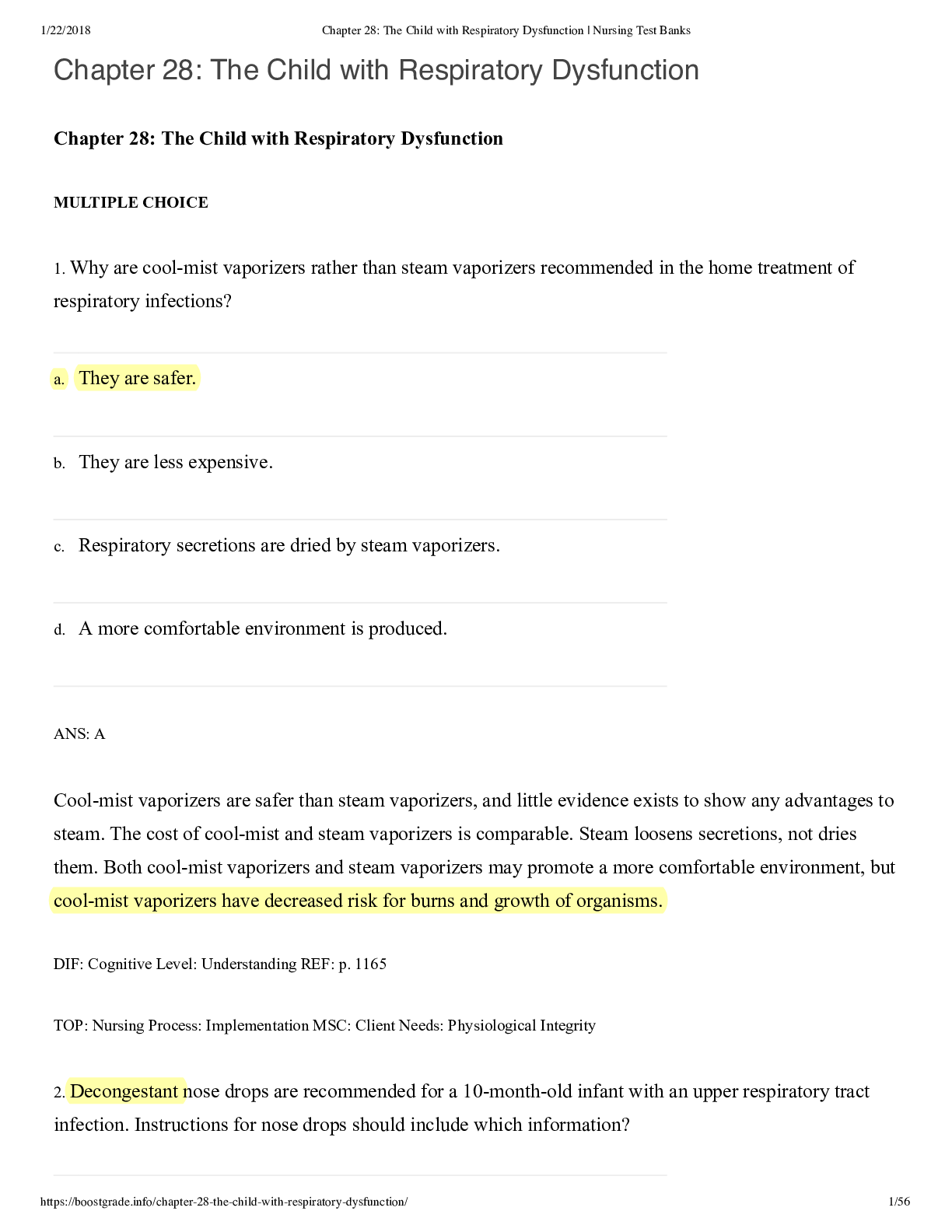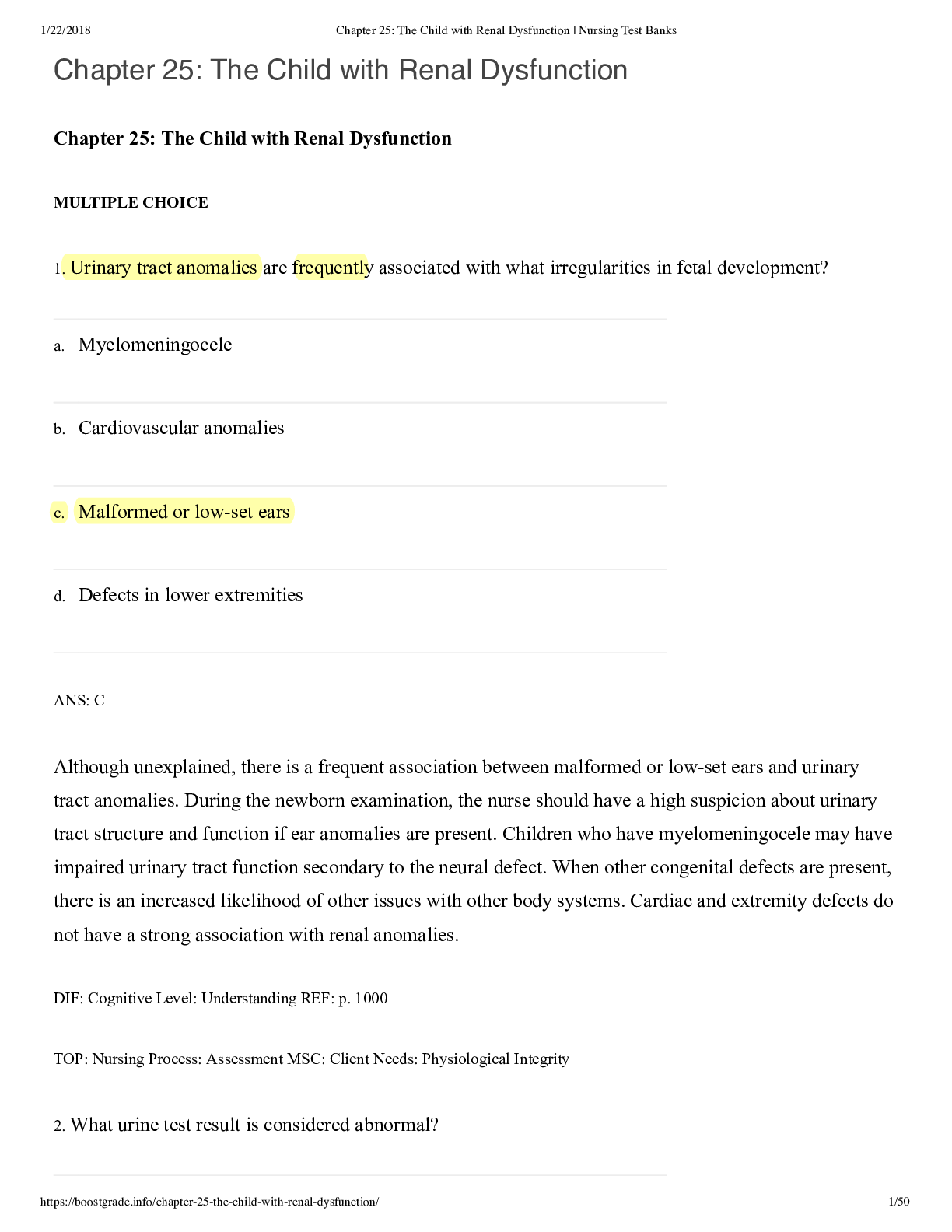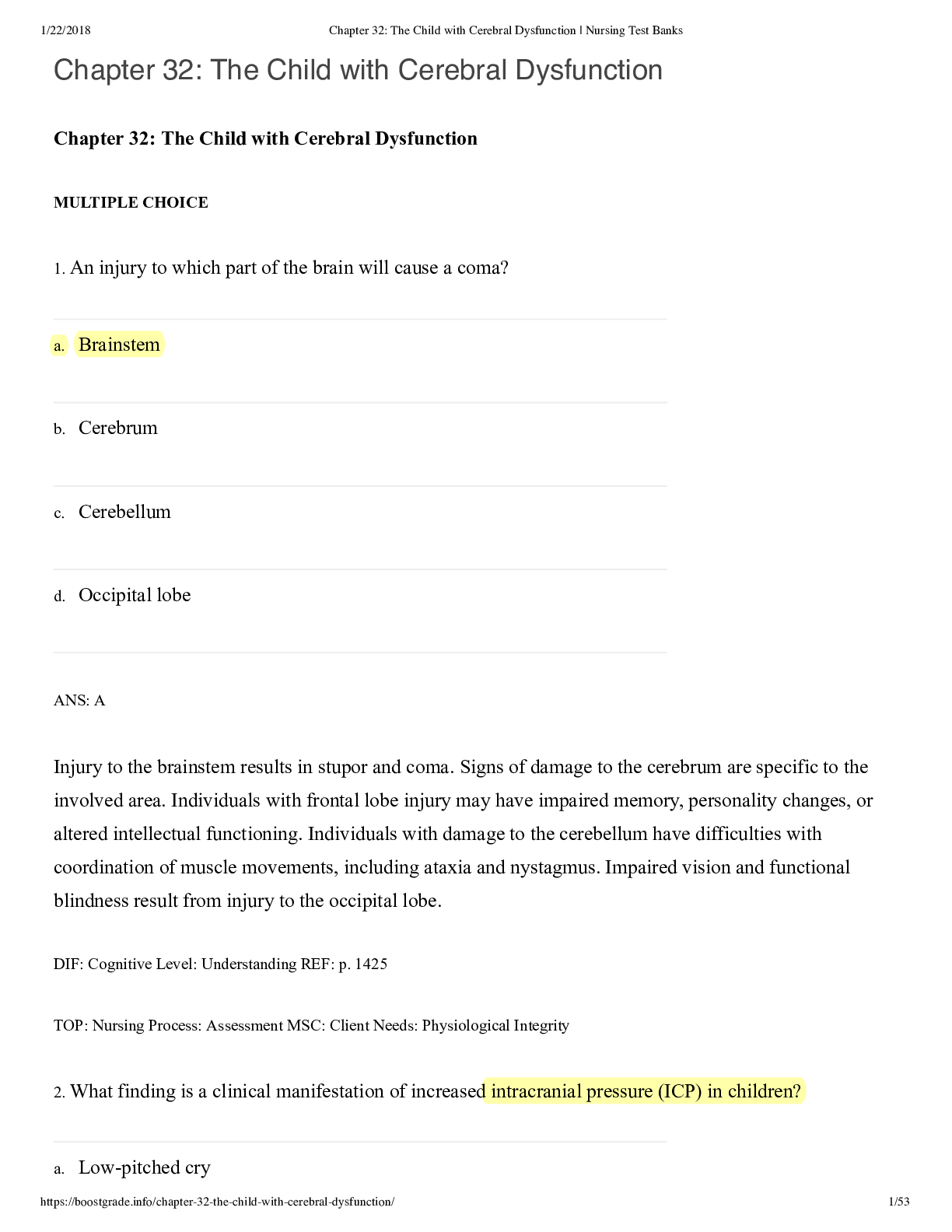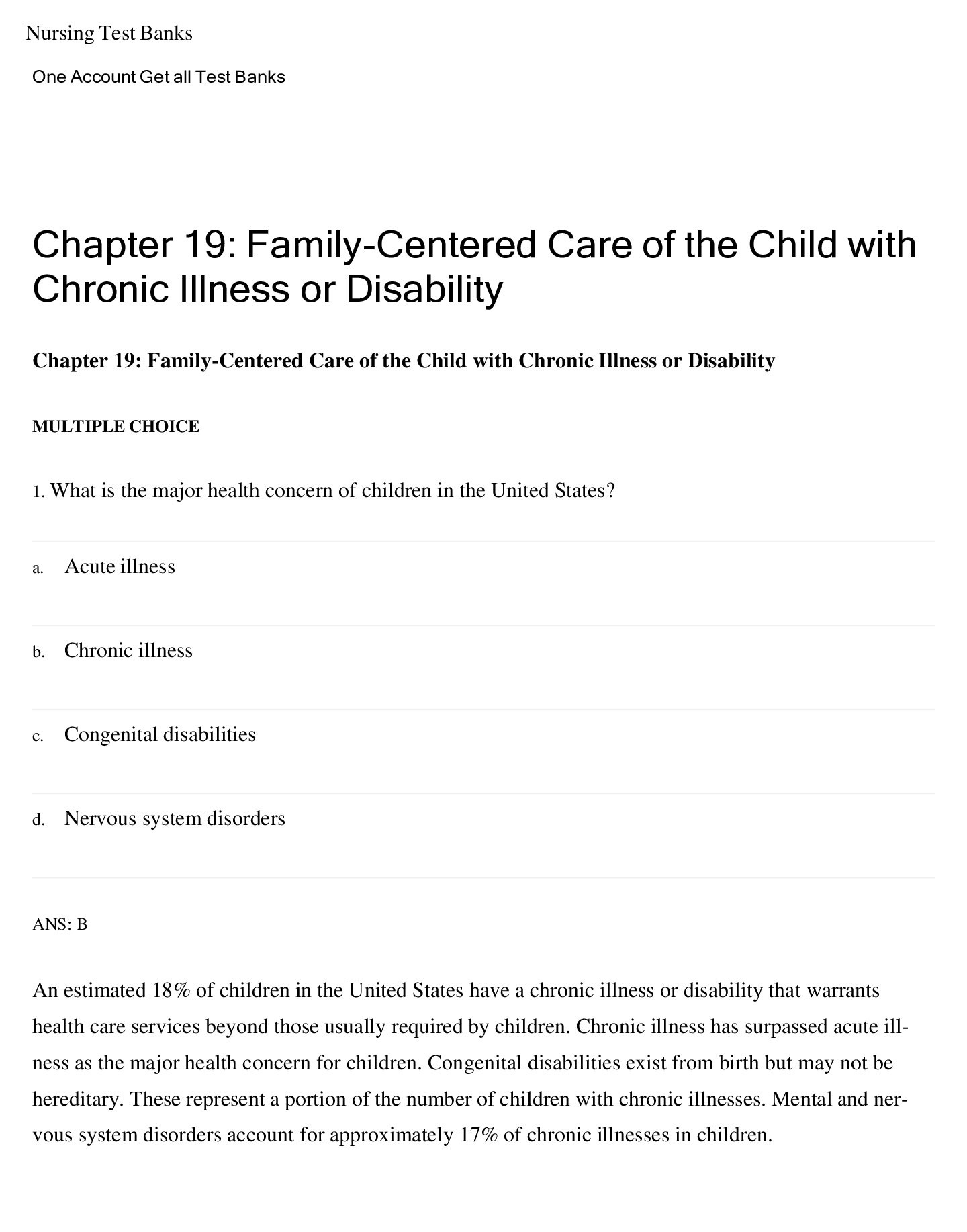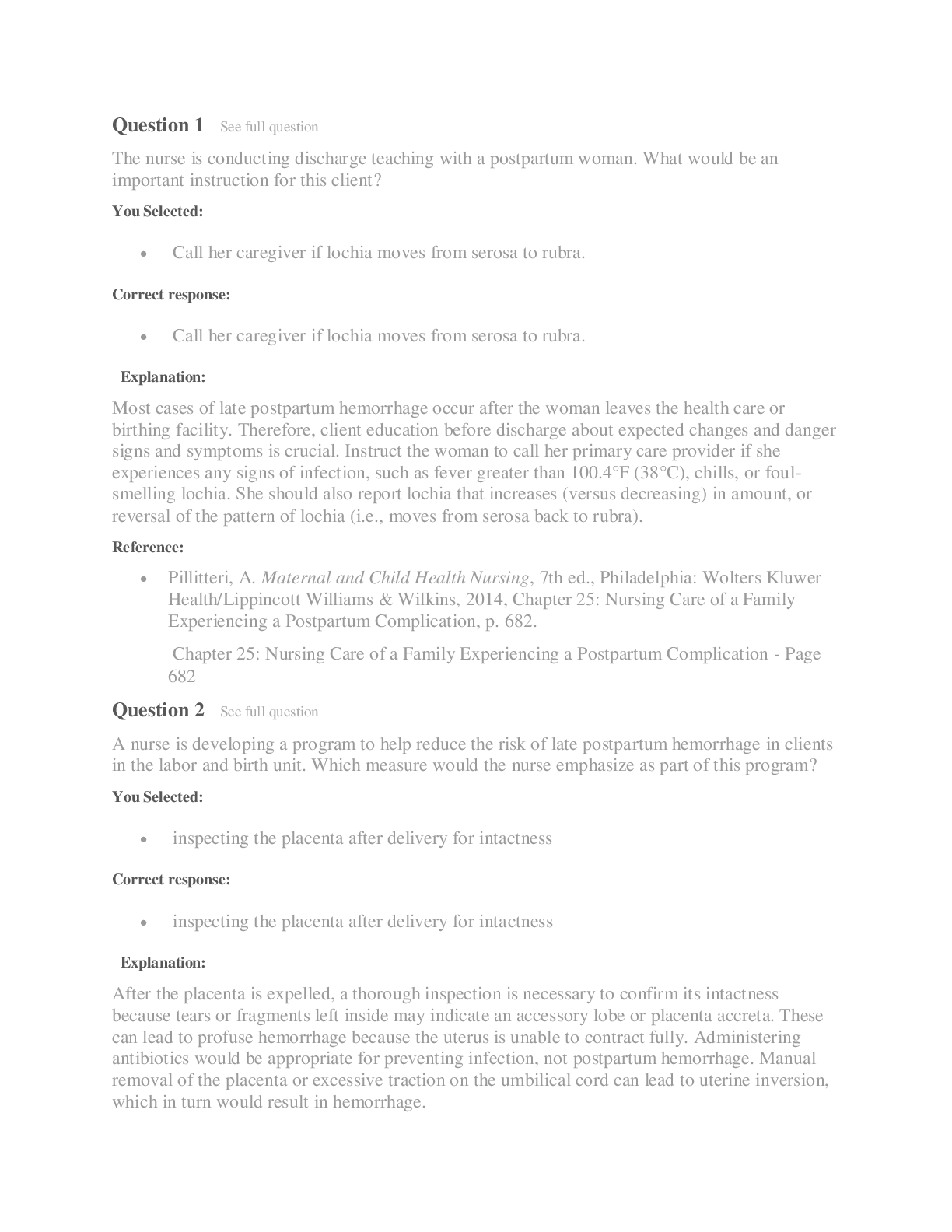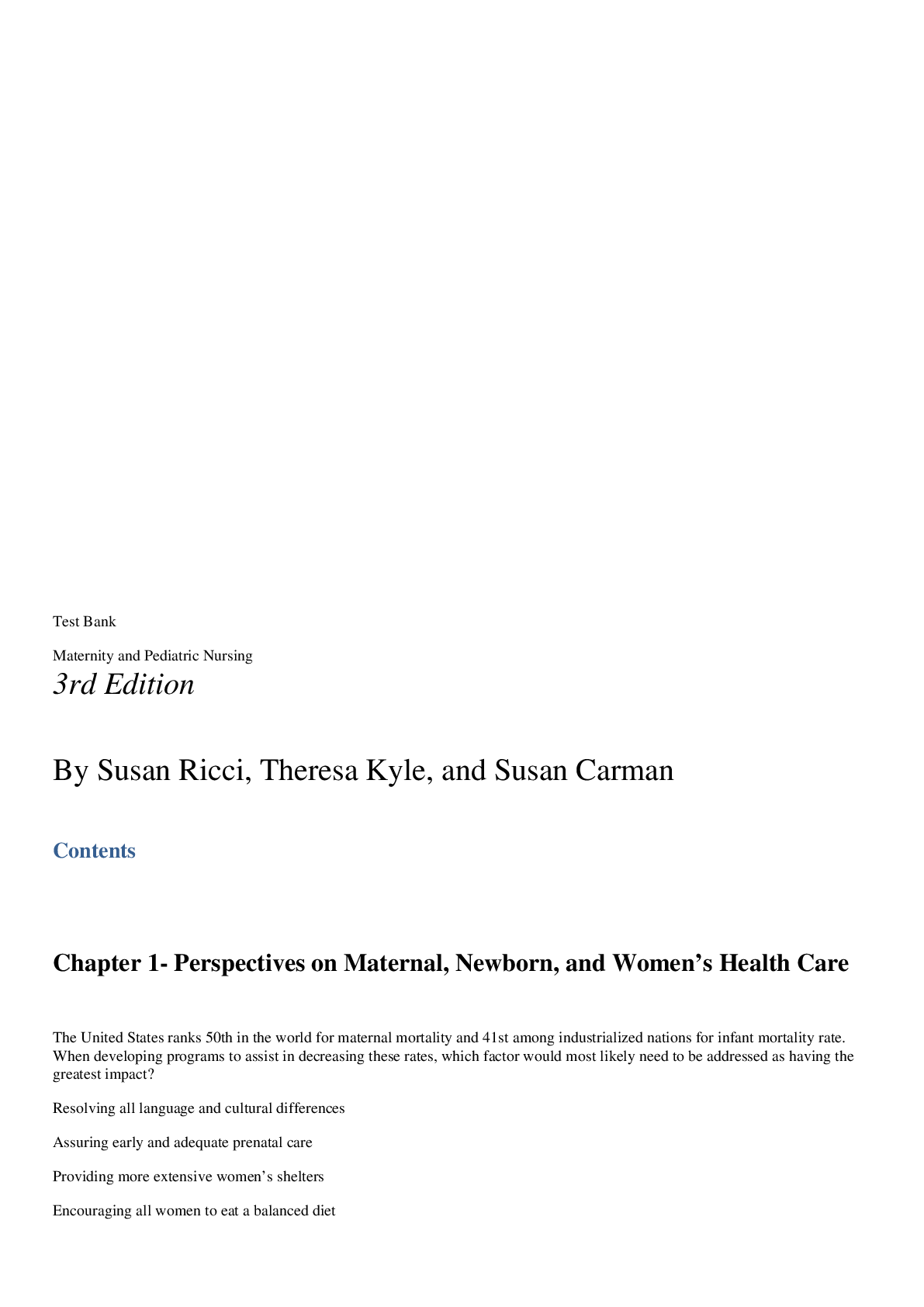*NURSING > TEST BANK > Test Bank - Maternal-Child Nursing (5th Edition by McKinney) Chapter 54: The Child with a Developmen (All)
Test Bank - Maternal-Child Nursing (5th Edition by McKinney) Chapter 54: The Child with a Developmental Disability,100% CORRECT
Document Content and Description Below
Test Bank - Maternal-Child Nursing (5th Edition by McKinney) Chapter 54: The Child with a Developmental Disability MULTIPLE CHOICE 1. A parent whose child has been diagnosed with a cognitive defic... it should be counseled that intellectual impairment a. Is usually due to a genetic defect b. May be caused by a variety of factors c. Is rarely due to first trimester events d. Is usually caused by parental intellectual impairment ANS: B Feedback A Only a small percentage of children with intellectual impairment are affected by a genetic defect. B There are a multitude of causes for intellectual impairment. In most cases, a specific cause has not been identified. NURSINGTB.COM C One third of children with intellectual impairment are affected by first trimester events. D Intellectual impairment can be transmitted to a child only if the parent has a genetic disorder. PTS: 1 DIF: Cognitive Level: Comprehension REF: p. 1480 OBJ: Nursing Process: Planning MSC: Client Needs: Health Promotion and Maintenance 2. A parent asks the nurse why a developmental assessment is being conducted for a child during a routine well-child visit. The nurse answers based on the knowledge that routine developmental assessments during well-child visits are a. Not necessary unless the parents request them b. The best method for early detection of cognitive disorders c. Frightening to parents and children and should be avoided d. Valuable in measuring intelligence in children ANS: B Feedback A Developmental assessment is a component of all well-child examinations. B Early detection of cognitive disorders can be facilitated through assessment of development at each well-child examination. C Developmental assessments are not frightening when the parent and child are educated about the purpose of the assessment. D Developmental assessments are not intended to measure intelligence. PTS: 1 DIF: Cognitive Level: Application REF: p. 1483 OBJ: Nursing Process: Implementation MSC: Client Needs: Health Promotion and Maintenance 3. The father of a child recently diagnosed with developmental delay is very rude and hostile toward the nurses This father was cooperative during the childs evaluation a month ago. What is the best explanation for this change in parental behavior? a. The father is exhibiting symptoms of a psychiatric illness. b. The father may be abusing the child. NURSINGTB.COM c. The father is resentful of the time he is missing from work for this appointment. d. The father is experiencing a symptom of grief. ANS: D Feedback A One cannot determine that a parent is exhibiting symptoms of a psychiatric illness on the basis of a single situation. B The scenario does not give any information to suggest child abuse. C Although the father may have difficulty balancing his work schedule with medical appointments for his child, a more likely explanation for his behavior change is that he is grieving the loss of a normal child. D After a child is diagnosed with a developmental delay, families typically experience a cycle of grieving that is repeated when developmental milestones are not met. PTS: 1 DIF: Cognitive Level: Application REF: p. 1485 OBJ: Nursing Process: Evaluation MSC: Client Needs: Psychosocial Integrity 4. An appropriate nursing diagnosis for a child with a cognitive dysfunction who has a limited ability to anticipate danger is a. Impaired social interaction b. Deficient knowledge c. Risk for injury d. Ineffective coping ANS: C Feedback A Impaired social interaction is indeed a concern for the child with a cognitive disorder but does not address the limited ability to anticipate danger. B Because of the childs cognitive deficit, knowledge will not be retained and will not decrease the risk for injury. C The nurse needs to know that limited cognitive abilities to anticipate danger lead to risk for injury. NURSINGTB.COM D Ineffective individual coping does not address the limited ability to anticipate danger. PTS: 1 DIF: Cognitive Level: Application REF: p. 1485 OBJ: Nursing Process: Diagnosis MSC: Client Needs: Health Promotion and Maintenance 5. Anticipatory guidance for the family of a preadolescent with a cognitive dysfunction should include information about a. Institutional placement b. Sexual development c. Sterilization d. Clothing ANS: B Feedback A Preadolescence does not require the child to be institutionalized. B Preadolescents who have a cognitive dysfunction may have normal sexual development without the emotional and cognitive abilities to deal with it. It is important to assist the family and child through this developmental stage. C Sterilization is not an appropriate intervention when a child has a cognitive dysfunction. D By the time a child reaches preadolescence, the family should have received counseling on age-appropriate clothing. PTS: 1 DIF: Cognitive Level: Application REF: p. 1486 OBJ: Nursing Process: Planning MSC: Client Needs: Health Promotion and Maintenance 6. What should be the major consideration when selecting toys for a child with an intellectual or developmenta disability? a. Safety b. Age appropriateness c. Ability to provide exercise NURSINGTB.COM d. Ability to teach useful skills ANS: A Feedback A Safety is the primary concern in selecting recreational and exercise activities for all children. This is especially true for children who are intellectually disabled. B Age appropriateness should be considered in the selection of toys, but safety is of paramount importance. C Ability to provide exercise should be considered in the selection of toys, but safety is of paramount importance. D Ability to teach useful skills should be considered in the selection of toys, but safety is of paramount importance. PTS: 1 DIF: Cognitive Level: Analysis REF: p. 1484 OBJ: Nursing Process: Implementation MSC: Client Needs: Safe and Effective Care Environment 7. Appropriate interventions to facilitate socialization of the cognitively impaired child include a. Providing age-appropriate toys and play activities b. Providing peer experiences, such as scouting, when older c. Avoiding exposure to strangers who may not understand cognitive development d. Emphasizing mastery of physical skills because they are delayed more often than verbal skills ANS: B Feedback A Providing age-appropriate toys and play activities is important. However, peer interactions will better facilitate social development. B The acquisition of social skills is a complex task. Children of all ages need peer relationships. Parents should enroll the child in preschool. When older, they should have peer experiences similar to other children such as group outings, Boy and Girl Scouts, and Special Olympics. C Parents should expose the child to strangers so that the child can practice social skills. NURSINGTB.COM D Verbal skills are delayed more than physical skills. PTS: 1 DIF: Cognitive Level: Comprehension REF: p. 1485 OBJ: Nursing Process: Implementation MSC: Client Needs: Psychosocial Integrity 8. A newborn assessment shows separated sagittal suture, oblique palpebral fissures, depressed nasal bridge, protruding tongue, and transverse palmar creases. These findings are most suggestive of a. Microcephaly b. Down syndrome c. Cerebral palsy d. Fragile X syndrome ANS: B Feedback A The infant with microcephaly has a small head. B These are characteristics associated with Down syndrome. C Cerebral palsy is a diagnosis not usually made at birth. No characteristic physical signs are present. D The infant with fragile X syndrome has increased head circumference; long, wide, and/or protruding ears; long, narrow face with prominent jaw; hypotonia; and high arched palate. PTS: 1 DIF: Cognitive Level: Comprehension REF: p. 1488 OBJ: Nursing Process: Assessment MSC: Client Needs: Physiologic Integrity 9. The infant with Down syndrome is closely monitored during the first year of life for what serious condition? a. Thyroid complications b. Orthopedic malformations c. Dental malformation d. Cardiac abnormalities ANS: D Feedback NURSINGTB.COM A Infants with Down syndrome are not known to have thyroid complications. B Orthopedic malformations may be present, but special attention is given to assessment for cardiac and gastrointestinal abnormalities. C Dental malformations are not a major concern compared with the life-threatening complications of cardiac defects. D The high incidence of cardiac defects in children with Down syndrome makes assessment for signs and symptoms of these defects important during the first year. Clinicians recommend the child be monitored frequently throughout the first 12 months of life, including a full cardiac workup. PTS: 1 DIF: Cognitive Level: Comprehension REF: p. 1487 | Box 54-4 OBJ: Nursing Process: Assessment MSC: Client Needs: Health Promotion and Maintenance 10. Many of the physical characteristics of Down syndrome present feeding problems. Care of the infant should include a. Delaying feeding solid foods until the tongue thrust has stopped b. Modifying diet as necessary to minimize the diarrhea that often occurs c. Providing calories appropriate to childs age d. Using special bottles that may assist the infant with feeding ANS: D Feedback A The child has a protruding tongue, which makes feeding difficult. The parents must persist with feeding while the child continues the physiologic response of the tongue thrust. B The child is predisposed to constipation. C Calories should be appropriate to the childs weight and growth needs, not age. D Breastfeeding may not be possible if the infants muscle tone or sucking reflex is immature. Mothers should be encouraged to pump breast milk and use special bottles for assistance with feeding. Some children with Down syndrome can breastfeed adequately. PTS: 1 DIF: Cognitive Level: Analysis REF: pN.U1R4S89INGTB.COM OBJ: Nursing Process: Implementation MSC: Client Needs: Physiologic Integrity 11. What action is contraindicated when a child with Down syndrome is hospitalized? a. Determine the childs vocabulary for specific body functions. b. Assess the childs hearing and visual capabilities. c. Encourage parents to leave the child alone for extended periods of time. d. Have meals served at the childs usual meal times. ANS: C Feedback A To communicate effectively with the child, it is important to know the childs particular vocabulary for specific body functions. B Children with Down syndrome have a high incidence of hearing loss and vision problems and should have hearing and vision assessed whenever they are in a health care facility. C The child with Down syndrome needs routine schedules and consistency. Having familiar people present, especially parents, helps to decrease the childs anxiety. D Routine schedules and consistency are important to children. PTS: 1 DIF: Cognitive Level: Application REF: p. 1489 OBJ: Nursing Process: Planning MSC: Client Needs: Psychosocial Integrity 12. The child with Down syndrome should be evaluated for which condition before participating in some sports? a. Hyperflexibility b. Cutis marmorata c. Atlantoaxial instability d. Speckling of iris (Brushfield spots) ANS: C Feedback NURSINGTB.COM A Although hyperflexibility is characteristic of Down syndrome, it does not affect the childs ability to participate in sports. B Although cutis marmorata is characteristic of Down syndrome, it does not affect the childs ability to participate in sports. C Children with Down syndrome are at risk for atlantoaxial instability. Before participating in sports that put stress on the head and neck, a radiologic examination should be done. D Although Brushfield spots are characteristic of Down syndrome, they do not affect the childs ability to participate in sports. PTS: 1 DIF: Cognitive Level: Comprehension REF: p. 1488 OBJ: Nursing Process: Assessment MSC: Client Needs: Physiologic Integrity 13. A nurse is giving a parent information about autism. Which statement made by the parent indicates understanding of the teaching? a. Autism is characterized by periods of remission and exacerbation. b. The onset of autism usually occurs before 3 years of age. c. Children with autism have imitation and gesturing skills. d. Autism can be treated effectively with medication. ANS: B Feedback A Autism does not have periods of remission and exacerbation. B The onset of autism usually occurs before 3 years of age. C Autistic children lack imitative skills. D Medications are of limited use in children with autism. PTS: 1 DIF: Cognitive Level: Application REF: p. 1494 OBJ: Nursing Process: Evaluation MSC: Client Needs: Health Promotion and Maintenance 14. What should the nurse keep in mind when planning to communicate with a child who has autism? a. The child has normal verbal commNuUniRcSaItiNoGn.TB.COM b. Expect the child to use sign language. c. The child may exhibit monotone speech and echolalia. d. The child is not listening if she is not looking at the nurse. ANS: C Feedback A The child has impaired verbal communication and abnormalities in the production of speech. B Some autistic children may use sign language, but it is not assumed. C Children with autism have abnormalities in the production of speech such as a monotone voice or echolalia, or inappropriate volume, pitch, rate, rhythm, or intonation. D Children with autism often are reluctant to initiate direct eye contact. PTS: 1 DIF: Cognitive Level: Application REF: p. 1496 OBJ: Nursing Process: Planning MSC: Client Needs: Psychosocial Integrity 15. Developmental delays, self-injury, fecal smearing, and severe temper tantrums in a preschool child are symptoms of a. Down syndrome b. Intellectual disability c. Psychosocial deprivation d. Separation anxiety ANS: B Feedback A Down syndrome is often identified at birth by characteristic facial and head features, such as brachycephaly (disproportionate shortness of the head); flat profile; inner epicanthal folds; wide, flat nasal bridge; narrow, high-arched palate; protruding tongue; and small, short ears, which may be low set. Although intellectual impairment may be present, the symptoms listed are not the primary ones expected in the diagnosis of Down syndrome. B These are symptoms of intellNecUtRuaSlINdiGsaTbBil.iCtyO.M C Psychosocial deprivation may be a cause of mild intellectual disability. The symptoms listed are characteristic of severe intellectual disability. D Symptoms of separation anxiety include protest, despair, and detachment. PTS: 1 DIF: Cognitive Level: Comprehension REF: p. 1482 | Box 54-2 OBJ: Nursing Process: Assessment MSC: Client Needs: Physiologic Integrity 16. Throughout their life span, cognitively impaired children are less capable of managing environmental challenges and are at risk for a. Nutritional deficits b. Visual impairments c. Physical injuries d. Psychiatric problems ANS: C Feedback A Nutritional deficits are related more to dietary habits and the caregivers understanding of nutrition. B Visual impairments are unrelated to cognitive impairment. C Safety is a challenge for cognitively impaired children. Decreased capability to manage environmental challenges may lead to physical injuries. D Psychiatric problems may coexist with cognitive impairment; however, they are not environmental challenges. PTS: 1 DIF: Cognitive Level: Application REF: p. 1484 OBJ: Nursing Process: Assessment MSC: Client Needs: Health Promotion and Maintenance 17. Which statement best describes Fragile X syndrome? a. Chromosomal defect affecting only females b. Chromosomal defect that follows the pattern of X-linked recessive disorders c. Second most common genetic cauNseUoRfScIoNgGniTtiBv.eCiOmMpairment d. Most common cause of noninherited cognitive impairment ANS: C Feedback A Fragile X primarily affects males. B Fragile X follows the pattern of X-linked dominant with reduced manifestation of the syndrome in female and moderate to severe dysfunction in males. C Fragile X syndrome is the most common inherited cause of cognitive impairment and the second most common cause of cognitive impairment after Down syndrome. D Fragile X is inherited. PTS: 1 DIF: Cognitive Level: Comprehension REF: p. 1490 OBJ: Nursing Process: Assessment MSC: Client Needs: Physiologic Integrity 18. The nurse is providing counseling to the mother of a child diagnosed with fragile X syndrome. She explains to the mother that fragile X syndrome is a. Most commonly seen in girls b. Acquired after birth c. Usually transmitted by the male carrier d. Usually transmitted by the female carrier ANS: D Feedback A Fragile X syndrome is most common in males. B Fragile X syndrome is congenital. C Fragile X syndrome is not transmitted by a male carrier. D The gene causing fragile X syndrome is transmitted by the mother. PTS: 1 DIF: Cognitive Level: Application REF: p. 1490 NURSINGTB.COM OBJ: Nursing Process: Implementation MSC: Client Needs: Health Promotion and Maintenance 19. The best setting for daytime care for a 5-year-old autistic child whose mother works is a. Private day care b. Public school c. His own home with a sitter d. A specialized program that facilitates interaction by use of behavioral methods ANS: D Feedback A Daycare programs generally do not have resources to meet the needs of severely impaired children. B To best meet the needs of an autistic child, the public school may refer the child to a specialized program. C A sitter might not have the skills to interact with an autistic child. D Autistic children can benefit from specialized educational programs that address their special needs. PTS: 1 DIF: Cognitive Level: Application REF: pp. 1496-1497 OBJ: Nursing Process: Planning MSC: Client Needs: Health Promotion and Maintenance 20. Parents have learned that their 6-year-old child has autism. The nurse may help the parents to cope by explaining that the child may a. Have an extremely developed skill in a particular area b. Outgrow the condition by early adulthood c. Have average social skills d. Have age-appropriate language skills ANS: A Feedback NURSINGTB.COM A Some children with autism have an extremely developed skill in a particular area such as mathematics or music. B No evidence supports that autism is outgrown. C Autistic children have abnormal ways of relating to people (social skills). D Speech and language skills are usually delayed in autistic children. PTS: 1 DIF: Cognitive Level: Application REF: p. 1495 OBJ: Nursing Process: Implementation MSC: Client Needs: Psychosocial Integrity 21. A child with autism hospitalized with asthma. The nurse should plan care so that the a. Parents expectations are met. b. Childs routine habits and preferences are maintained. c. Child is supported through the autistic crisis. d. Parents need not be at the hospital. ANS: B Feedback A Focus of care is on the childs needs rather than on the parents desires. B Children with autism are often unable to tolerate even slight changes in routine. The childs routine habits and preferences are important to maintain. C Autism is a life-long condition. D The presence of the parents is almost always required when an autistic child is hospitalized. PTS: 1 DIF: Cognitive Level: Application REF: p. 1497 OBJ: Nursing Process: Planning MSC: Client Needs: Psychosocial Integrity MULTIPLE RESPONSE 1. You are the nurse assessing a 3-year-old child who has characteristics of autism. Which observed behaviors are associated with autism? Select all that apply. a. The child flicks the light in the examination room on and off repetitiously. NURSINGTB.COM b. The child has a flat affect. c. The child demonstrates imitation and gesturing skills. d. Mother reports the child has no interest in playing with other children. e. The child is able to make eye contact. ANS: A, B, D Feedback Correct Self-stimulation is common and generally involves repetition of a sensory stimulus. Autistic children generally show a fixed, unchanging response to a particular stimulus. Autistic children generally play alone or involve others only as mere objects. Incorrect Autistic children lack imitative skills. These children lack social ability and make poor eye contact. PTS: 1 DIF: Cognitive Level: Analysis REF: pp. 1495-1496 OBJ: Nursing Process: Assessment MSC: Client Needs: Health Promotion and Maintenance 2. A nurse is assessing a newborn for facial feature characteristics associated with fetal alcohol syndrome: Which characteristics should the nurse expect to assess? Select all that apply. a. Short palpebral fissures b. Smooth philtrum c. Low set ears d. Inner epicanthal folds e. Thin upper lip ANS: A, B, E Feedback Correct Infants with fetal alcohol syndrome may have characteristic facial features, including short palpebral fissures, a smooth philtrum (the vertical groove in the median portion of the upper lip), and a thin upper lip. Incorrect NURSINGTB.COM Low set ears and inner epicanthal folds are associated with Down syndrome. PTS: 1 DIF: Cognitive Level: Analysis REF: p. 1492 OBJ: Nursing Process: Assessment MSC: Client Needs: Physiologic Integrity 3. A nurse should plan to implement which interventions for a child admitted with inorganic failure to thrive? Select all that apply. a. Observation of parent-child interactions b. Assignment of different nurses to care for the child from day to day c. Use of 28 calorie per ounce concentrated formulas d. Administration of daily multivitamin supplements e. Role modeling appropriate adult-child interactions ANS: A, D, E Feedback Correct The nurse should plan to assess parent-child interactions when a child is admitted for nonorganic failure to thrive. The observations should include how the child is held and fed, how eye contact is initiated and maintained, and the facial expressions of both the child and the caregiver during interactions. Role modeling and teaching appropriate adult-child interactions (including holding, touching, and feeding the child) will facilitate appropriate parent-child relationships, enhance parents confidence in caring for their child, and facilitate expression by the parents of realistic expectations based on the childs developmental needs. Daily multivitamin supplements with minerals are often prescribed to ensure that specific nutritional deficiencies do not occur in the course of rapid growth. The nursing staff assigned to care for the child should be consistent. Incorrect Providing a consistent caregiver from the nursing staff increases trust and provides the child with an adult who anticipates his or her needs and who is able to role model child care to the parent. Caloric enrichment of food is essential, and formula may be concentrated in titrated amounts up to 24 calories per ounce. Greater concentrations can lead to diarrhea and dehydration. PTS: 1 DIF: Cognitive Level: Analysis REF: p. 1493 OBJ: Nursing Process: Implementation MSC: Client Needs: Physiologic Integrity COMPLETION 1. Unlike fragile X syndrome, which affects primarily males, (RS) is almost exclusively linked to female gender. ANS: Rett syndrome NURSINGTB.COM An estimated 1:10,000 to 1:15,000 females are affected. RS is characterized by an initial period of normal development with symptoms emerging between the ages of 6 and 18 months. Social and intellectual development stops and seizures along with physical disabilities emerge. PTS: 1 DIF: Cognitive Level: Knowledge REF: p. 1491 OBJ: Nursing Process: Assessment MSC: Client Needs: Physiologic Integrity, Psychological Integrity [Show More]
Last updated: 1 year ago
Preview 1 out of 19 pages
Instant download

Buy this document to get the full access instantly
Instant Download Access after purchase
Add to cartInstant download
Reviews( 0 )
Document information
Connected school, study & course
About the document
Uploaded On
Mar 25, 2021
Number of pages
19
Written in
Additional information
This document has been written for:
Uploaded
Mar 25, 2021
Downloads
0
Views
35













